Total Knee Replacement Recovery Guide
If knee pain becomes so severe that it disrupts daily activities or is associated with swelling, tenderness, or redness, it is essential to seek medical attention.
At Complete Orthopedics, our highly experienced knee specialists excel in treating knee pain through both non-surgical and surgical approaches, including the Knee Replacement technique. This state-of-the-art procedure is customized to each patient’s unique anatomy, leading to better results and faster recovery.
With locations in New York City and Long Island, and affiliations with six major hospitals, we offer cutting-edge knee surgery and comprehensive orthopedic care. You can schedule appointments with our orthopedic surgeons online or by phone.
Discover the common causes and treatments for knee pain, and learn when the innovative Smart Knee Replacement is the most effective option.
Overview
Recovering from a total knee replacement is a slow process and can feel, in the immediate postoperative period, like very little progress is being made. However, a dedicated and consistent approach to recovering will always yield the best results. It is important to try to mobilize as soon as possible after your knee replacement surgery. This will be tricky immediately following the surgery as you will feel sore and have some pain, which will hopefully be controlled by the pain medications your surgeon will prescribe you.
If your pain is poorly controlled, it is important to let your surgeon know this so that your analgesic regimen can be altered to suit your needs. In the immediate postoperative period, you will have physical therapist assistance in getting up and on your feet in a safe and timely manner. They will help you get used to the feeling of your new knee and will teach you how to walk safely while your knee and tissues within the knee are still recovering from the surgery.
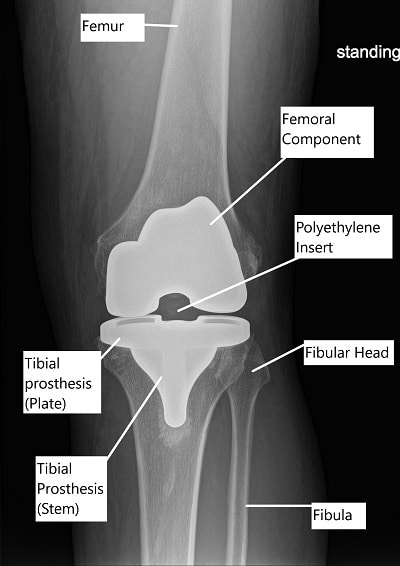
X-ray showing Total Knee Replacement.
It is important that you continue physical therapy assistance in the longer term recovery from your knee replacement surgery, as studies have shown consistently that patients who undergo a dedicated and standardized physical therapy regimen to recover from that knee replacement experience much better outcomes than those who do not.
Once you are mobilizing well and your immediate postoperative pain has subsided or is well controlled on your pain medication regimen, it then becomes important to focus on strengthening the knee once again. After the surgery, your muscles will be weak and this is normal to experience. It is important to focus on exercises that both improve the range of motion of the knee and also work on the strength of the muscles surrounding the knee. Often these exercises are very simple and do not require any elaborate equipments or aids to recovery.
You should follow the instructions that your surgeon has given you with regards to the dressings after your knee replacement surgery is completed. It is always important to follow the instructions given to you by your healthcare provider and not remove the dressings yourself or earlier than you have been instructed. Exposing the surgical incision too early on in the recovery process can risk a surgical site infection and this could potentially lead to infection in your knee replacement, which is a major complication and one that must be avoided at all costs.
You should attempt to wean off your pain medications as soon as possible – this is usually easiest to start doing one to two weeks after the surgery and you can continue weaning off your pain medications up to around 6 weeks following your knee replacement.
Pain after Total Knee Replacement
You will experience some postsurgical pain in the area that has been operated on after your knee replacement. This is normal and you will be prescribed medications by your surgeon to attempt to control your pain and bring it within tolerable levels. It is important to remember that, at this stage, it is unrealistic to expect that there will be no pain and so a small amount of soreness in and around the knee is normal. It will take one to two weeks for the postsurgical pain to dissipate; however, this does not indicate that the knee has fully healed.
There will be some discomfort in the knee up to around 6 weeks following the surgery and in some patients, this may even persist up to 3 months following the surgery. The pain is caused by a number of factors including the muscles around the knee recovering from the surgery and regaining strength that they have lost as a result of the surgery, as well as other tissues around the knee healing and getting used to the new biomechanics of the knee joint.
It is also important to remember that a small subset of patients even experience pain up to and beyond 6 months and even a year following the surgery and that this is not necessarily an indication that the knee replacement has failed. Pain that lasts long after the surgery can be for a number of reasons and it is important to communicate your experience of this pain with your surgeon or healthcare provider effectively so that they can best direct any therapeutic intervention in your ongoing care.
Knee Replacement Recovery Timeline
Immediately following the knee replacement surgery, depending on the type of anesthetic that you received, you will either wake up or come around from any sedating medications that you have been given during the surgery in the recovery room. Your knee will be wrapped in bandages and a surgical dressing. If you received a spinal anesthetic for the knee replacement, you will still be numb through approximately your waist downwards at this stage. If you received a general anesthetic, you will not be numb and you may notice soreness and pain in the knee at this point in time. Patients who receive a spinal anesthetic usually find that this wears off after approximately 8 hours and this is the point at which those patients will notice soreness in the knee.
Provided that you recover well in the recovery room without any complications, you will be transferred to a ward and they will begin your postoperative pain medication regimen after your arrival. During your inpatient stay, you will be aided by physical therapist and nurses as well as other healthcare professionals in getting back on your feet and mobilizing, usually with a gait aid such as a Zimmer frame or a cane, or a rollator walker.
It is anticipated that you will be in hospital for one to two days following the surgery and as previously mentioned, barring any complications, you will be discharged from hospital when it is appropriate for you to go home. At home, you will take home prescriptions to continue your pain medication regimen in the immediate postoperative period and over the first 6 weeks, you will notice a significant reduction in the amount of pain that you experience in your knee and this is the most appropriate time to wean off your pain medication.
You will also notice significant strength gains in the knee provided that you adhere fully with the postoperative rehabilitation instructions that your surgeon or physical therapist given you. These gains in strength will be most dramatic in the first 6 weeks, but will actually continue up until 6 months following the surgery at which time most patients have regained the majority of their function and strength in the muscle surrounding the knee and the knee joint itself. At this point, you should be able to walk without a gait aid and should notice that your preoperative pain has now disappeared.
There can be changes in the anatomy and biomechanics of the knee joint up to one or even two years after the surgery, these are usually subtle and go unnoticed by the patient, but there are also a subset of patients who do notice differences in their gait patterns, knee strength and even pain even up to these points in time.
Even well function knee replacements do have a finite lifespan and although many patients can go many years without experiencing significant complications, it is important for your surgeon to follow you upon a regular basis to ensure that the development of any complication is caught early and appropriately treated. Some knee replacement patients will experience a phenomenon known as osteolysis, which happens as a result of the plastic liner of the knee replacement gradually wearing away and causing the bone around the knee replacement itself to be eaten away. This can be avoided with judicious and regular followup monitoring, but for some patients will mean that they require a revision of their knee replacement.
Knee Replacement Recovery in the Elderly
Although the process of recovering from a knee replacement is no different for an elderly patient than it is for a younger patient and the steps are identical, it is important to remember that elderly patients typically lack the physiological reserve of their younger counterparts. This will mean that essentially the process takes longer and gaining strength back in the knee and subsequently having a well-functioning and asymptomatic knee may take longer in patients that are significantly deconditioned or have been living with arthritis for such a long period of time that this has caused their gait patterns to alter significantly and their muscles to atrophy.
This should be taken into consideration when counseling patients who are elderly that require knee replacement surgery and consistent reminders of this during rehabilitation help to highlight the altered expectation for the recovery timeline in this patient population.
Life after Knee Replacement
The goal of knee replacement surgery is to improve your quality of life and restore function that has been lost as a result of arthritis in the knee, there are a number of activities that knee replacement patients find that even years after the surgery, they are unable to do comfortably. The most common complaint in knee replacement patients is that they have difficulty performing tasks that require kneeling. This is normal and whether or not the patient has had their kneecap replaced as part of their knee replacement does not seem to affect this phenomenon.
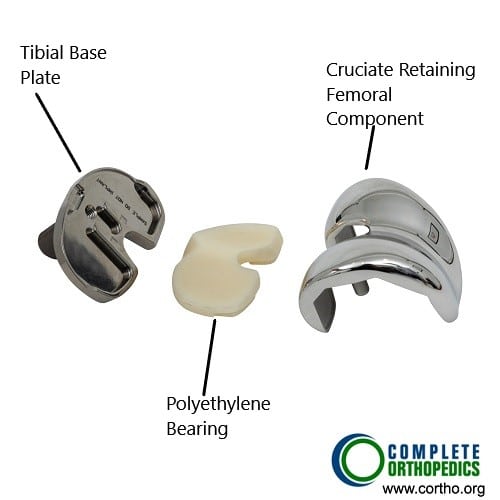
Total knee replacement prosthetic components
The image shows the prosthetic components consisting of cobalt chromium alloy metallic tibial and femoral components and polyethylene insert. The femoral component and insert are cruciate retaining. The choice between cruciate retaining and posterior stabilized implant is made depending upon the disease in the knee joint and the integrity of the posterior cruciate ligament.
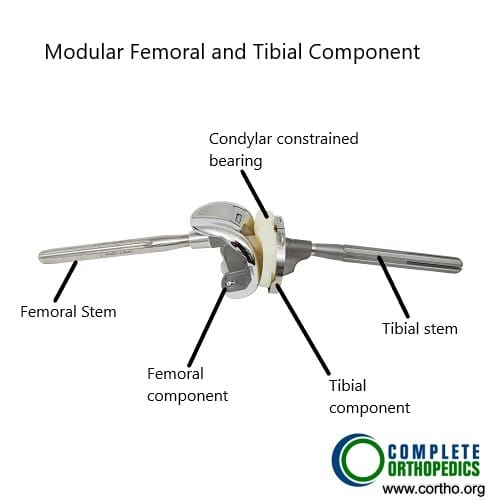
Modular femoral and tibial components along with polyethylene insert
Modular prosthetic components differ from primary knee replacement components as they allow the surgeon to make intraoperative changes. The surgeon may add bone augments or stems to achieve additional stability. The constrained insert allows stable range of motion.
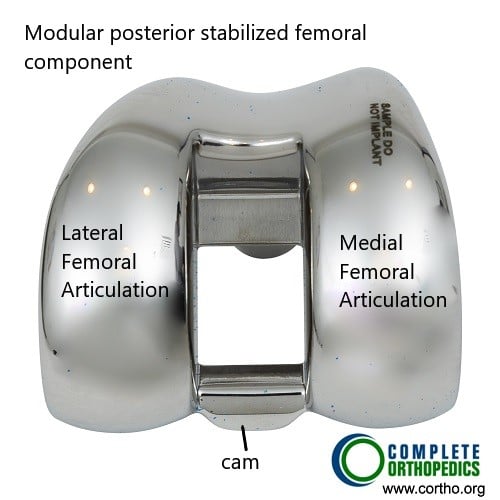
Modular femoral component (posterior stabilized)
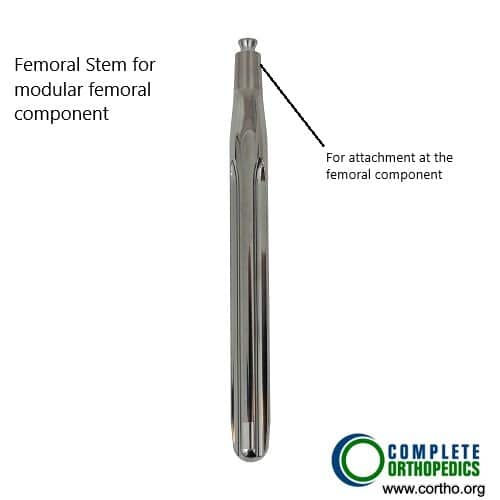
Femoral component stem
The above images show prosthetic modular femoral components. The modular components have an attachment for stems and attachment of metaphyseal sleeves and metal wedges. The sleeves and wedges are used to fill in bone gaps encountered intraoperatively.
The components of the knee replacement were never designed to bear weight through the patellofemoral compartment and this is the most common reason why patients find it uncomfortable to do so. Although there has been no proven danger in doing this in terms of causing complications such as aseptic loosening or periprosthetic fracture, it remains the case that the vast majority of knee replacement patients are unable to kneel on their prosthetic knees comfortably. This is important to bear in mind when considering knee replacement surgery.
Many surgeons will also recommend avoiding activities that are particularly jarring to the knee. This is controversial and there are no scientific bases to restricting patient’s activities after knee replacement, but once again some patients find that they are unable to enjoy certain sporting activities to the same level that they used to, e.g., tennis, soccer, long distance road running. That is not to say that the patient is unable to perform these activities, but once again expectations must be managed in terms of the length of time or the level of performance that should be expected in the sports after a knee replacement surgery.
It is also important to remember that the greater the amount of stress that you put your knee through the quicker that it is going to wear and the higher the risk of requiring a revision replacement at some point in the future.
When can a patient return to work?
This is a common question after knee replacement surgery and entirely depends on the nature of work the patient performs as part of their occupation. For those patients who work in jobs that are relatively sedentary such as office work, returning to work after 2 to 3 weeks is perfectly reasonable; however, for patients whose work demands more of them physically, e.g., fireman, police officer, these patients are usually recommended to wait at least 6 weeks before returning to work.
This is because muscle recovery is usually sufficient by 6 weeks to allow for the normal duties of these more physically demanding occupations at this point in time. However, it is also a case that even for the more physically demanding occupations, if a modification of these duties is available to the patients for the postoperative recovery period then this would potentially allow for an early return to work.
How much should I be walking after a Knee Replacement?
Strictly speaking, there is no limit to the amount of walking that you can do following a knee replacement. Your surgeon will not place a distance or time limit on your walking activities, as most patients find that their knee that is still recovering from surgery, and this will limit them instead. Walking is an excellent exercise to help promote recovery and healing in the knee and many patients find that the more walking that they can do, the quicker they recover from the surgery and the more functional they are in the long term. However, walking should also be supplemented with other exercises that demand a greater range of motion out of the knee such as a stationary bike or an elliptical trainer.
Knee Replacement Recovery Exercises
Although you will be advised on specific exercises that you can do by your physical therapist, the exercises that you should focus on the most, particularly in the early recovery period, are exercises that work on range of motion, degree of bend in the knee as well as developing strength in the quadriceps muscles. As soon as you feel you are able to get onto a stationary or recumbent bike, you should do so. This is an excellent exercise as it is very low impact, but works on range of motion and strength, and the knee and can be aided by the contralateral side.
Working on range of motion and strength can be achieved by dangling your leg over the side of a chair or bed and extending the knee so that the leg is fully outstretched and holding it against gravity for several seconds before then allowing gravity to bend the knee again. This is a very simple exercise, but also very effective and can be done anywhere with relative ease and does not require any special equipment.
Another excellent exercise to develop quadriceps strength that does not require any special weight equipment and can also be done anywhere is the straight leg raise. Lying down on a flat surface and raising the operative leg up in the air keeping it fully out straight and holding it in the air for a count of 8 seconds before allowing it to gently come back down to the flat surface again and then repeating this for 8 repetitions twice a day will help with quadriceps recovery tremendously. This can be done in bed before getting up in the morning and just after going to bed at night.
Knee Replacement Exercises to Avoid
Most patients who are motivated try to do too much too quickly and will want to get into the weight room to work on strengthening their knee before the knee is ready to do this. Particular exercises that you should avoid are resisted knee extensions, as these place a great deal of stress on the patellofemoral joint and will aggravate and exacerbate pain unnecessarily especially in the early postoperative period. It is also unnecessary to perform any resisted squats too early on in your recovery. Body weight squats up against a wall are usually a good place to start and over time, you should be able to gradually work your way back up to weighted squats.
What not to do after a knee replacement?
As previously mentioned, removing the dressings too early or before you are instructed to do so by your healthcare provider will increase the risk of developing an infection. This is important to avoid and as such leaving your dressings and following the postoperative care instructions that you are given is essential.
Trying to do too much too quickly is a common scenario particularly in younger patients. Recovery from the knee replacement is a slow process and many patients want to be back to a baseline level of activity within a few weeks of the surgery. This is simply not possible and we would encourage you to be patient and consistent with your exercises and rehabilitation protocols. Regular communication with your surgeon or healthcare provider if you have any concerns will be able to reassure you of your progress through the process of recovering.
Avoid trying to enter into sporting activity too quickly. Although it does frustrate patients when find they are unable to perform their sports as quickly as they want after the surgery, it can also put you at risk of developing an injury around tissues that are still in the process of healing. This can cause problematic injuries such as disruptions to your extensor mechanism of your knee and even periprosthetic fractures. These are major injuries that usually require surgical intervention and should be avoided at all costs.
What type of pain medication will I take after my Total Knee Replacement?
Most patients require some form of narcotic analgesic in the early postoperative period after their surgery. Each patient is different in how they respond to this type of pain medication and while others may have been prescribed one medication, this may not work the same for you as it did for them. As such, the first line medication may be different to a family member or friend to whom you have spoken who has already had their knee replaced. We usually use medications such as hydromorphone and oxycodone in conjunction with medications such as Tylenol.
You are able to take these two medications together as their mechanism of action is different. It is important to remember that these medications do have side effects and experiencing nausea, constipation or drowsiness are all recognized side effects of narcotic analgesics. It is important to stick to the dosing schedule that your physician has indicated to you and that your pharmacist will reiterate to you at the time of filling your prescription.
Taking too many narcotic analgesics can result in worsening side effects without the benefit of improved pain relief and can even depress your respiratory drive causing you to breathe slower or stop breathing altogether. As such, it is essential that you do not exceed the maximum indicated dose on your prescription or medication container.
The ultimate goal is to wean off these medications within a few weeks of the surgery and to control your pain with less potent analgesics such as codeine or tramadol or even Tylenol.
How long will I be on pain medication after my Knee Replacement Surgery?
Every patient experiences recovery from a knee replacement surgery differentially and as such, everyone will require pain medication at different intervals and for different amounts of time. There is no standard approach to this, although generally we do expect patients to be weaned off their narcotic analgesics within 2 to 3 weeks of the surgery and by 6 weeks after the surgery should only be requiring occasional Tylenol or a less potent analgesic to control their pain.
With that being said, there are a number of different factors that can affect a person’s ability to tolerate pain medication or indeed their ability to have the pain medication kill their pain. As such, each medication regimen will be tailored to the individual. It is important to regularly communicate with your surgeon or healthcare provider regarding your experience of the pain and your current pain medication regimen, so that it can be altered to suit you and your needs.
Conclusion
Knee replacement surgery is well known to be highly successful and improves the lives of hundreds of patients every single day. If you think you may be a candidate for knee replacement, please come in and discuss with one of our surgeons the symptoms that you are having and we will be able to assess you and advise whether we feel that you are a candidate for a knee replacement.
Do you have more questions?
How long does it typically take to recover from a total knee replacement?
Recovery can take about 3 to 6 months for most patients to return to normal activities, but full recovery can take up to a year.
Is it normal to experience pain after a knee replacement?
Yes, some pain is normal as you heal. Pain management strategies will be provided by your medical team.
What are the best exercises to do after knee replacement surgery?
Exercises focusing on range of motion, strength, and flexibility, such as straight leg raises, ankle pumps, and knee bends, are recommended.
Can I go up and down stairs after knee replacement surgery?
Yes, but initially, you may need assistance and should use a handrail. Your therapist will guide you on the safest technique.
How often should I perform rehabilitation exercises?
Typically, exercises should be done 2-3 times daily as prescribed by your physical therapist.
When can I drive after a knee replacement?
You can usually drive 4-6 weeks after surgery if you can bend your knee enough to get in and out of the car and have regained sufficient muscle control.
s it normal to have swelling after knee replacement surgery?
Yes, swelling can persist for 3 to 6 months post-surgery. Use ice and elevate your leg to reduce swelling.
What should I do if I experience severe pain or swelling?
Contact your surgeon immediately as severe pain or swelling could indicate complications like infection or a blood clot.
Can I return to sports after knee replacement surgery?
Low-impact sports like swimming, cycling, and golfing are generally safe after recovery. High-impact sports should be avoided.
How can I prevent stiffness in my knee after surgery?
Regularly performing your prescribed exercises and using a continuous passive motion machine if recommended can help prevent stiffness.
What kind of diet should I follow during my recovery?
A balanced diet rich in protein, vitamins, and minerals supports healing. Staying hydrated is also important.
When can I return to work after knee replacement surgery?
It depends on your job. Sedentary jobs might be resumed in 4-6 weeks, while more physically demanding jobs might require 3 months or more.
How long will I need to use a walker or crutches?
This varies but typically, patients use them for 2-3 weeks post-surgery.
Can I travel after knee replacement surgery?
Short trips can be taken within a few weeks, but long trips, especially flights, should be discussed with your doctor to manage risks like blood clots.
What are signs of infection I should watch out for?
Signs include increased redness, warmth, swelling, drainage, and fever. Contact your surgeon if these occur.
How often should I follow up with my surgeon after surgery?
Follow-up visits are typically scheduled at 2 weeks, 6 weeks, 3 months, 6 months, and 1 year post-surgery.
Can I kneel after a knee replacement?
Many patients find kneeling uncomfortable even after recovery, but some can do it with practice and the guidance of a physical therapist.
Is it normal to hear clicking sounds from my knee after surgery?
Yes, some clicking is normal as the artificial joint moves but consult your surgeon if it is accompanied by pain or swelling.
Will I need to take antibiotics before dental work or other surgeries after a knee replacement?
Yes, you may need prophylactic antibiotics to prevent infection. Discuss this with your surgeon and dentist.
How can I improve my knee’s range of motion after surgery?
Consistent exercise, physical therapy, and using a continuous passive motion machine if recommended can help improve range of motion.
Can I sleep on my side after knee replacement surgery?
Yes, but you may need to place a pillow between your knees for comfort and support.
What kind of support or braces will I need post-surgery?
Initially, you may use a knee immobilizer, but as you progress, you will likely only need compression stockings to reduce swelling.
How can I avoid blood clots after knee replacement surgery?
Move around as much as possible, do your prescribed exercises, and wear compression stockings. Your doctor may also prescribe blood thinners.
